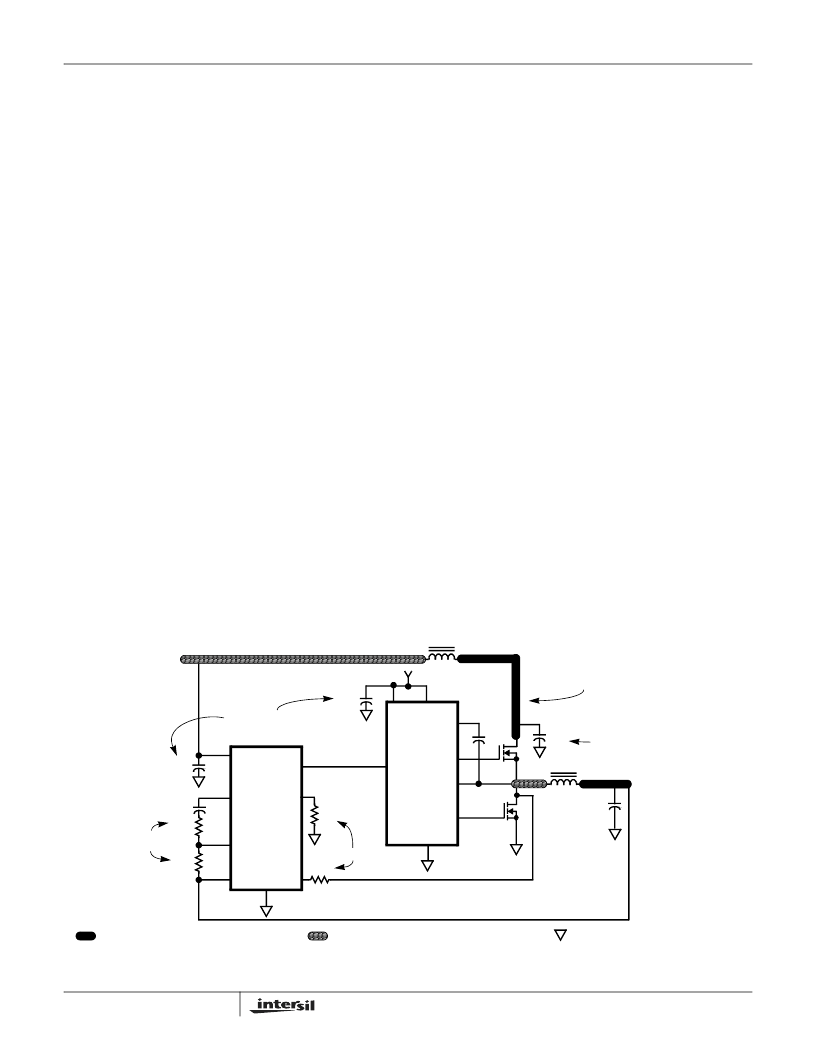- 您現(xiàn)在的位置:買賣IC網(wǎng) > PDF目錄385382 > HIP6301VCBZ (INTERSIL CORP) Microprocessor CORE Voltage Regulator Multi-Phase Buck PWM Controller PDF資料下載
參數(shù)資料
| 型號(hào): | HIP6301VCBZ |
| 廠商: | INTERSIL CORP |
| 元件分類: | 穩(wěn)壓器 |
| 英文描述: | Microprocessor CORE Voltage Regulator Multi-Phase Buck PWM Controller |
| 中文描述: | SWITCHING CONTROLLER, 1500 kHz SWITCHING FREQ-MAX, PDSO20 |
| 封裝: | LEAD FREE, PLASTIC, MS-013AC, SOIC-20 |
| 文件頁數(shù): | 16/20頁 |
| 文件大?。?/td> | 518K |
| 代理商: | HIP6301VCBZ |

16
FN9034.2
December 27, 2004
with vias to this layer. Dedicate another solid layer as a power
plane and break this plane into smaller islands of common voltage
levels. Keep the metal runs from the PHASE terminal to inductor
L
O1
short. The power plane should support the input power and
output power nodes. Use copper filled polygons on the top and
bottom circuit layers for the phase nodes. Use the remaining
printed circuit layers for small signal wiring. The wiring traces from
the driver IC to the MOSFET gate and source should be sized to
carry at least one ampere of current.
Component Selection Guidelines
Output Capacitor Selection
The output capacitor is selected to meet both the dynamic
load requirements and the voltage ripple requirements. The
load transient for the microprocessor CORE is characterized
by high slew rate (di/dt) current demands. In general,
multiple high quality capacitors of different size and dielectric
are paralleled to meet the design constraints.
Modern microprocessors produce severe transient load rates.
High frequency capacitors supply the initially transient current
and slow the load rate-of-change seen by the bulk capacitors.
The bulk filter capacitor values are generally determined by
the ESR (effective series resistance) and voltage rating
requirements rather than actual capacitance requirements.
High frequency decoupling capacitors should be placed as
close to the power pins of the load as physically possible. Be
careful not to add inductance in the circuit board wiring that
could cancel the usefulness of these low inductance
components. Consult with the manufacturer of the load on
specific decoupling requirements.
Use only specialized low-ESR capacitors intended for
switching-regulator applications for the bulk capacitors. The
bulk capacitor’s ESR determines the output ripple voltage
and the initial voltage drop following a high slew-rate
transient’s edge. In most cases, multiple capacitors of small
case size perform better than a single large case capacitor.
Bulk capacitor choices include aluminum electrolytic, OS-
Con, Tantalum and even ceramic dielectrics. An aluminum
electrolytic capacitor’s ESR value is related to the case size
with lower ESR available in larger case sizes. However, the
equivalent series inductance (ESL) of these capacitors
increases with case size and can reduce the usefulness of
the capacitor to high slew-rate transient loading.
Unfortunately, ESL is not a specified parameter. Consult the
capacitor manufacturer and measure the capacitor’s
impedance with frequency to select a suitable component.
Output Inductor Selection
One of the parameters limiting the converter’s response to a
load transient is the time required to change the inductor
current. Small inductors in a multi-phase converter reduces
the response time without significant increases in total ripple
current.
The output inductor of each power channel controls the
ripple current. The control IC is stable for channel ripple
current (peak-to-peak) up to twice the average current. A
single channel’s ripple current is approximately:
The current from multiple channels tend to cancel each other
and reduce the total ripple current. Figure 14 gives the total
ripple current as a function of duty cycle, normalized to the
parameter
at zero duty cycle. To determine
the total ripple current from the number of channels and the
duty cycle, multiply the y-axis value by
.
I
V
SW
V
–
-------------------------------
V
IN
---------------
×
=
VCORE
+12V
VIA CONNECTION TO GROUND PLANE
ISLAND ON POWER PLANE LAYER
ISLAND ON CIRCUIT PLANE LAYER
LO1
COUT
CIN
+5VIN
KEY
PHASE
VCC
USE INDIVIDUAL METAL RUNS
FOR EACH CHANNEL TO HELP
COMP
HIP6301V
PWM
R
T
R
IN
R
FB
C
BP
FB
VSEN
ISEN
R
SEN
HIP6601
CBOOT
CBP
C
T
V
CC
FS/DIS
PVCC
LOCATE NEXT TO IC PIN
LOCATE NEXT
TO FB PIN
LOCATE NEXT TO IC PIN(S)
ISOLATE OUTPUT STAGES
LOCATE NEAR TRANSISTOR
FIGURE 13. PRINTED CIRCUIT BOARD POWER PLANES AND ISLANDS
Vo
(
)
LxF
SW
(
)
Vo
(
)
LxF
SW
(
)
HIP6301V, HIP6302V
相關(guān)PDF資料 |
PDF描述 |
|---|---|
| HIP6311A | 150000 SYSTEM GATE 2.5 VOLT FPGA - NOT RECOMMENDED for NEW DESIGN |
| HIP6311ACB | Microprocessor CORE Voltage Regulator Multi-Phase Buck PWM Controller |
| HIP6311ACBZ | Microprocessor CORE Voltage Regulator Multi-Phase Buck PWM Controller |
| HIP6311ACBZ-T | Microprocessor CORE Voltage Regulator Multi-Phase Buck PWM Controller |
| HIP6311ACBZA | XCV150-5BGG352I - NOT RECOMMENDED for NEW DESIGN |
相關(guān)代理商/技術(shù)參數(shù) |
參數(shù)描述 |
|---|---|
| HIP6301VCBZA | 制造商:INTERSIL 制造商全稱:Intersil Corporation 功能描述:Microprocessor CORE Voltage Regulator Multi-Phase Buck PWM Controller |
| HIP6301VCBZA-T | 制造商:INTERSIL 制造商全稱:Intersil Corporation 功能描述:Microprocessor CORE Voltage Regulator Multi-Phase Buck PWM Controller |
| HIP6301VCBZ-T | 功能描述:電流型 PWM 控制器 MULTI-PHS CNTRLR VID ON THE FLYINTEL VID RoHS:否 制造商:Texas Instruments 開關(guān)頻率:27 KHz 上升時(shí)間: 下降時(shí)間: 工作電源電壓:6 V to 15 V 工作電源電流:1.5 mA 輸出端數(shù)量:1 最大工作溫度:+ 105 C 安裝風(fēng)格:SMD/SMT 封裝 / 箱體:TSSOP-14 |
| HIP6302 | 制造商:INTERSIL 制造商全稱:Intersil Corporation 功能描述:Microprocessor CORE Voltage Regulator Multi-Phase Buck PWM Controller |
| HIP6302_04 | 制造商:INTERSIL 制造商全稱:Intersil Corporation 功能描述:Microprocessor CORE Voltage Regulator Multi-Phase Buck PWM Controller |
發(fā)布緊急采購,3分鐘左右您將得到回復(fù)。